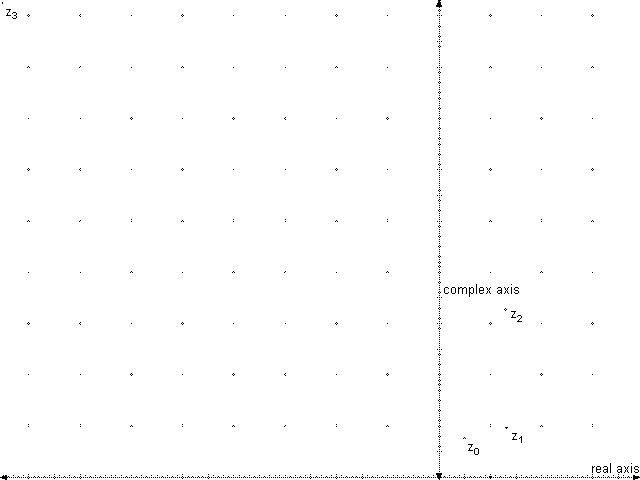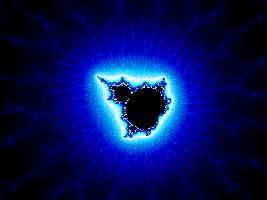How would you describe the picture above? ...
Some people call it a bug. If we use
this bug analogy, naming parts of it the head, the body, the feet, the antennas, tell why
it is a fractal? (Definition) We will be able to see this
self-similarity better in an upcoming Java applet.
This set is created in the complex plane. Mathematicians say it has an approximate scale
of symmetry. The Mandelbrot set is represented by all the inside points coded black by
the computer. Benoit Mandelbrot, an IBM researcher and Yale professor, discovered this set
in 1980 while he was studying cases of a much older set, the Julia set. Well, it
is not a very old set either. It was named around 1920 after the French mathematician, Gaston
Julia. Julia picked a fixed complex number, c, and studied the function
fc(z) = z2 + c putting in different values of z.
With the creation of computers, we are all able to see the beauty that this set displays.
Back to the Mandelbrot set, how is it created?
Pick a complex point. Say you
pick
0.5 + 0.75 i. It is labeled z0. Locate it on the graph.

The next point is z1. It is approximately 1.3125 + .96 i. We get this point
by squaring the complex number, 0.5 + 0.75 i, and adding the result to the original number.
This process can be written as a function, z1 = z02 +
z0.
Now, to get z2, we square z1 and add it to z0.
The iteration process continues: z0, z02 + z0, (z0
2 + z0)2 + z0, ((z0
2 + z0)2 + z0)2 + z0, ...
We can write it as a recursive function zn+1 = zn2 +
z0.
Notice how z3 is far away compared to the other points. It appears that this, z0
was not a good choice to be in the Mandelbrot set, since after 3 iterations, it moves out.
Good choices are numbers that stay "nearby" after n iterations. People who study this
set find that it fits inside
the square -1.2 < x < 1.2 and -2 < y < 0.5.
Try out some for yourself. Next page.

